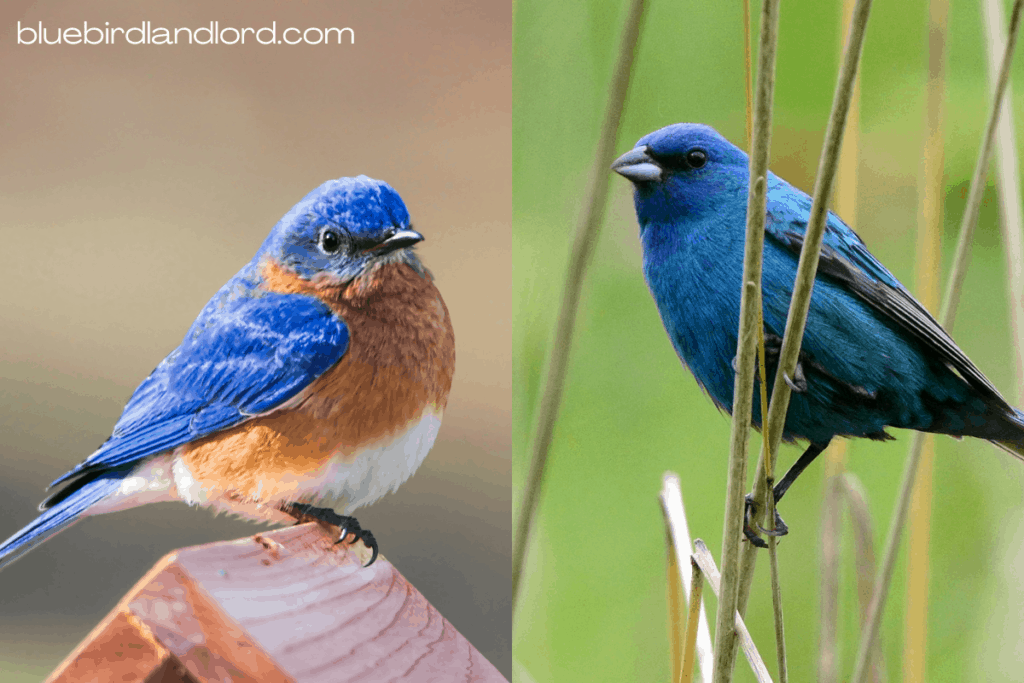
The Eastern Bluebird is my all-time favorite bird. Growing up, I loved it when these beautifully blue birds would visit my yard. People love Eastern Bluebirds for their spectacularly blue feathers that flash a vivid blue as they fly by. But are all blue birds bluebirds? People often confuse Eastern Bluebirds with another blue-colored bird – the Indigo Bunting. Because both Eastern Bluebirds and Indigo Buntings are small songbirds with blue wings, distinguishing between the two species can be challenging for new birdwatchers. In this article, I’ll provide you with a comprehensive guide to help differentiate between these two delightful songbirds – Eastern Bluebirds and Indigo Buntings.
What’s the difference between Eastern Bluebirds and Indigo Buntings?
Eastern Bluebirds and Indigo Buntings are both blue songbirds that inhabit the eastern half of North America. While male Eastern Bluebirds are mostly blue with a patch of reddish-orange on their chest, male Indigo Buntings are blue all-over. The females of each species are slightly duller in color than their male counterparts. Eastern Bluebirds nest in cavities or nest boxes while Indigo Buntings nest in trees. Another difference is that Eastern Bluebirds have a thin bill for eating insects, and Indigo Buntings have a thick, finch-like bill, perfect for eating seeds.
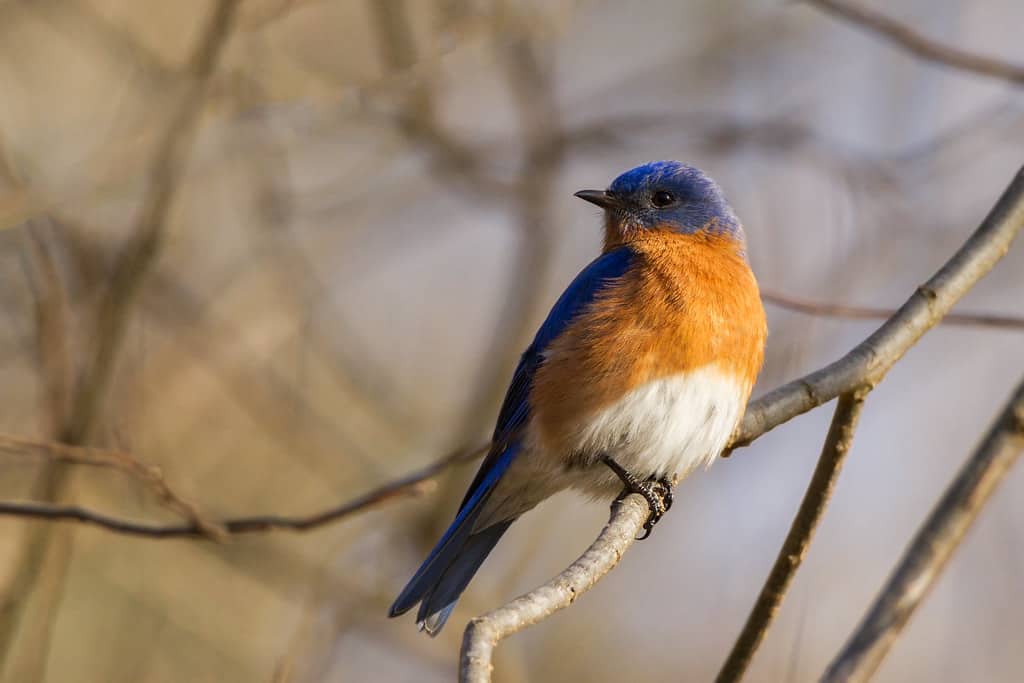
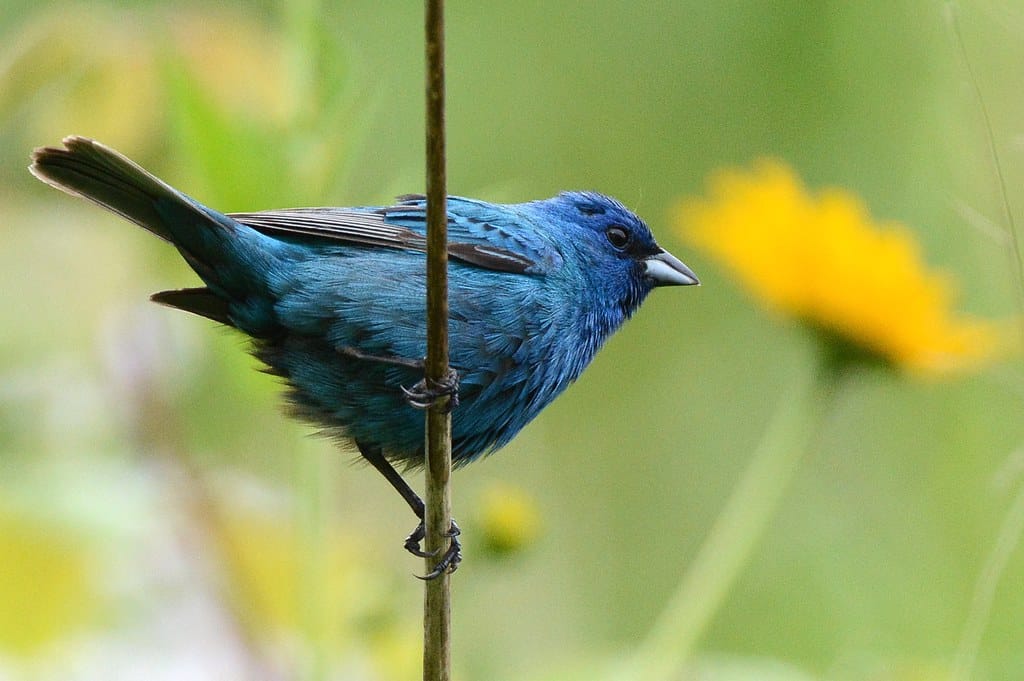
In this article, I want to go over a few of the key differences between Eastern Bluebirds and Indigo Buntings. Hopefully you’ll be able to identify each of these birds in your back yard the next time you see them!
Table of Contents
- Where Do They Live? – Eastern Bluebirds vs. Indigo Buntings
- Where to Look for Them
- Physical Differences
- Nesting Differences
- Do Eastern Bluebirds and Indigo Buntings Get Along?
- Conclusion
Where Do They Live? – Eastern Bluebirds vs. Indigo Buntings
Eastern Bluebirds – Typical Range
Generally speaking, Eastern Bluebirds reside across the eastern half of North America, extending all the way down to Central American countries like Nicaragua. They received their name, the Eastern Bluebird, because, when compared to other species of bluebirds, they tend to only live east of the Rocky Mountains. Learn more about other species of bluebirds here, if you are interested.
The yellow and green portions of the map below show the Eastern Bluebirds’ breeding range and year-round range respectively. The blue portion of the map shows their migratory range during the non-breeding season.

Indigo Buntings – Typical Range
Indigo Buntings, on the other hand, can also be found throughout the eastern half of North America, from the Great Plains eastward. In addition, there may be populations of this species breeding in the western United States, particularly in Arizona, California, and Utah. With the seasonal change, Indigo Buntings exhibit a migratory pattern to coastal regions of Mexico, the Caribbean, and Central America during the winter months.
The yellow portion of the map below indicates Indigo Buntings’ range during breeding season. Green indicates their migratory range and blue shows their winter range.
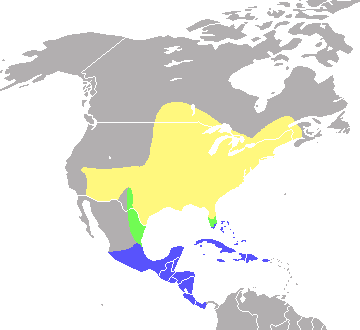
Where to Look for Them: Eastern Bluebirds vs. Indigo Buntings
Where to Look for Eastern Bluebirds

Eastern Bluebirds prefer an open area with sparse amounts of vegetation and scattered trees. As cavity nesters, they prefer to live where there are plenty of natural tree cavities or artificial nest boxes present. It is quite a common sight to encounter Eastern Bluebirds out in the country perching on fence posts, telephone wires, and low tree branches, scanning for insects on the ground. When they spot an insect, they’ll usually swoop down, grab the insect with their beak, and then flutter back up to their perch to enjoy their catch.
You can look for Eastern Bluebirds in the following places:
- Edge of fields
- Golf course
- Fence posts
- Low perches
- Telephone wires
If you want to attract bluebirds to your yard THIS YEAR, the best place to start is the Bluebird Landlord Audio Guide. In this audio guide, I’ll tell you everything you need to know about attracting bluebirds in just 59 minutes and 38 seconds.
Check out the Bluebird Landlord Audio Guide here.
Where to Look for Indigo Buntings

While Eastern Bluebirds prefer open areas with scattered trees, Indigo Buntings frequent rather weedy and brushy habitats. According to the Cornell Lab of Ornithology, Indigo Buntings prefer spots where “fields meet forests” (source). They prefer to nest in areas at the edge of farms, near the woods, in deciduous woodlands, near swamps, and even abandoned farming sites.
You can look for Indigo Buntings in the following places:
- Hedgerows
- Brushy roadsides
- Overgrown yards
- Tree tops
- Tall shrubs
- Telephone wires
Now, let’s consider the physical differences between Eastern Bluebirds and Indigo Buntings.
Physical Differences: Eastern Bluebirds vs. Indigo Buntings
Eastern Bluebird Physical Characteristics
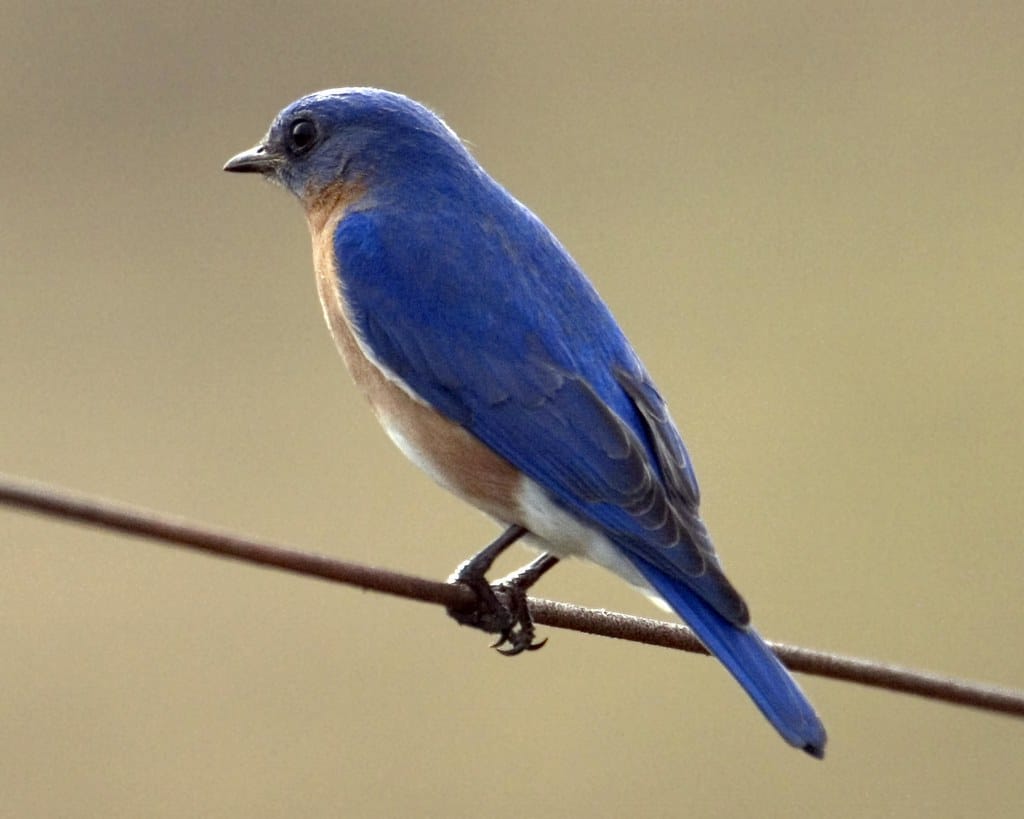
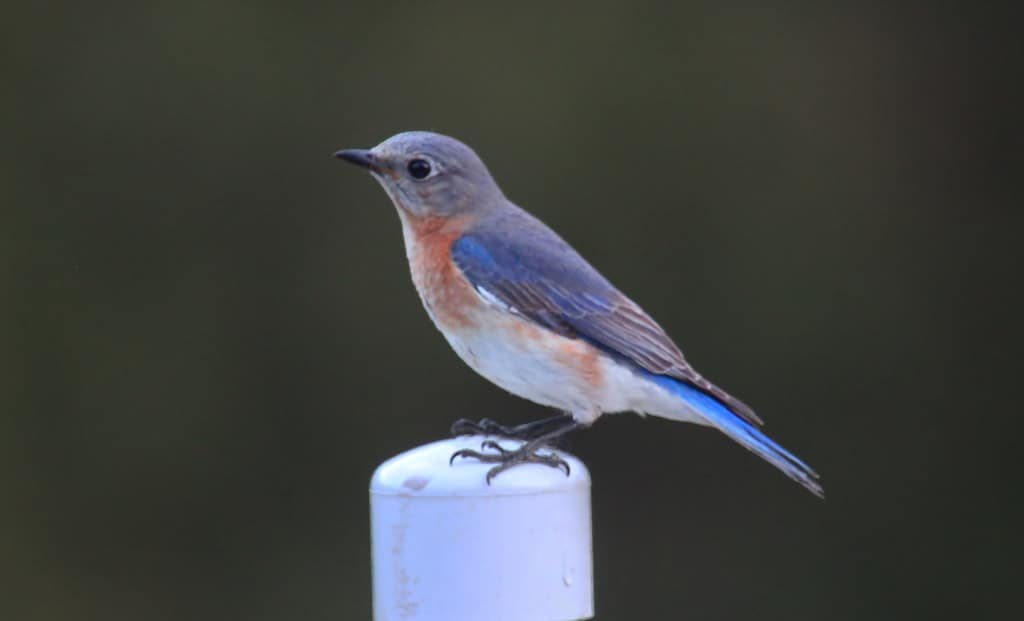
Female Eastern Bluebird Photo by DrPhotoMoto is licensed under CC BY-ND 2.0
When it comes to size, Eastern Bluebirds are approximately two-thirds the size of an American Robin. The Eastern Bluebird is as a small thrush, similar to the Robin, with a distinctive rounded head, a short, straight bill, and blue wings. Eastern Bluebirds have long wingspans in contrast to their relatively shorter tail and legs. To be specific, they measure about 7″ long on average with a wingspan of 9.8-12.6″.
Male Eastern Bluebirds have bright blue plumage with a rusty-colored breast and a white stomach. The females are slightly larger than their men counterparts with duller brownish-gray feathers and a slight blue hue on their wings and tail feathers.
Indigo Bunting Physical Characteristics
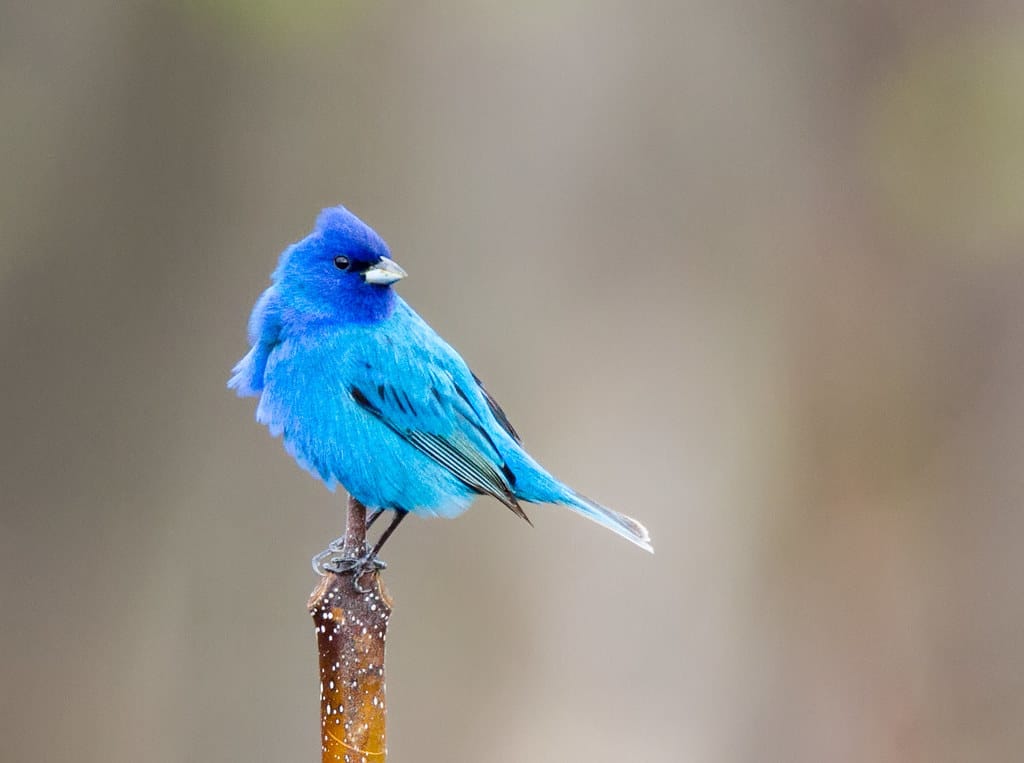
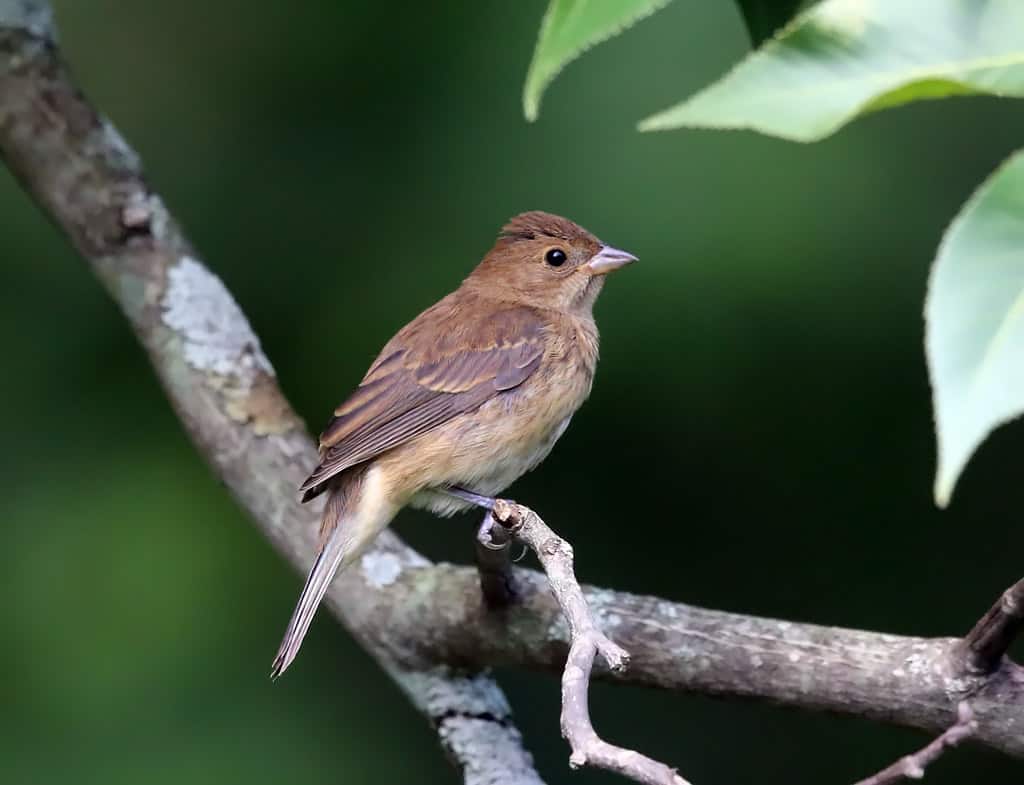
Similarly, male Indigo Buntings have brilliant blue plumage during the breeding season with a slight purple crown. But unlike the Eastern Bluebirds, they don’t have an orange-colored breast. Adult female Indigo Buntings have dark brown feathers with faint dark streaks on their underparts. Since they are so brown in color, if you are expecting a blue bird you will probably look right past the female Indigo Bunting. Indigo Buntings are also relatively small birds, measuring about 4.5-5.5” in length. Unlike Eastern Bluebirds, they have small, hard, conical bills, which are perfect for eating seeds.
Diet Differences: Eastern Bluebirds vs. Indigo Buntings
Eastern Bluebird Diet
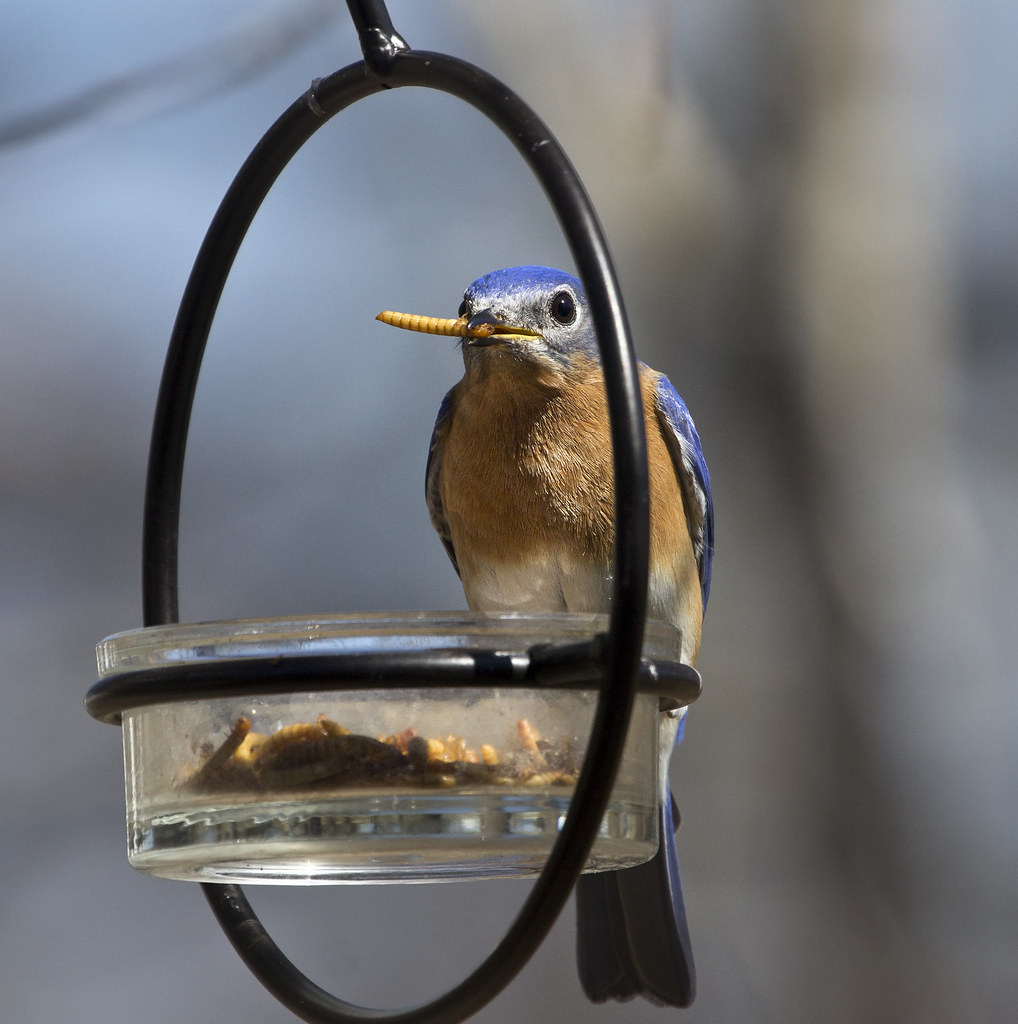
Photo by watts_photos is licensed under CC BY 2.0
Most of the Eastern Bluebird’s diet is composed of caterpillars, spiders, and crickets, and other insects. They’ll also eat mealworms when they’re offered at a feeder. Since they’re omnivores, as the weather gets colder and insects become more scarce, Eastern Bluebirds will shift to eating berries and certain seeds during the winter. Some of their preferred winter foods include blueberry, honeysuckle, juniper berry, and wild holly. Eastern Bluebirds can also be attracted to a bird feeder year-round that is stocked with live mealworms, their favorite food. You can see the bluebird feeders and mealworm sources I that I use on my Recommended Tools page here.
Indigo Bunting Diet

Photo by jackanapes is licensed under CC BY-NC-ND 2.0
Although they are also omnivores, most of the Indigo Bunting’s diet consists of seeds. During the summer, they forage for small seeds, buds, berries, and occasionally insects. When winter approaches, they switch to mostly seeds and some fruit. Indigo Buntings can be attracted to bird feeders that are stocked with Nyjer seed (sometimes called thistle seed). You can get a bag of Nyjer seed here from Chewy.com, and this is the feeder that I recommend using for Indigo Buntings.
Nesting Differences: Eastern Bluebirds vs. Indigo Buntings
Eastern Bluebird Nests

Photo by photogism is licensed under CC BY-NC 2.0
Eastern Bluebirds are cavity nesters. This means that they only build their nests in bird houses or in natural cavities (usually holes in dead trees or old woodpecker holes). Since they are cavity nesters, Eastern Bluebirds are unable to build nests on the branches of trees like many other birds do. So, if you see a bring blue bird going in and out of a hole in a tree, or in and out of a bird house, it’s probably a bluebird!
Once Eastern Bluebirds have found a suitable nesting site, the female will complete the nest by weaving together dried grasses, natural materials, and pine needles. Female Eastern Bluebirds will lay about 3-5 pale blue or white eggs per clutch that she will then incubate for 11-19 days. After the eggs hatch, both Eastern Bluebirds will continue to feed their young for around 17-21 days until they leave the nest.
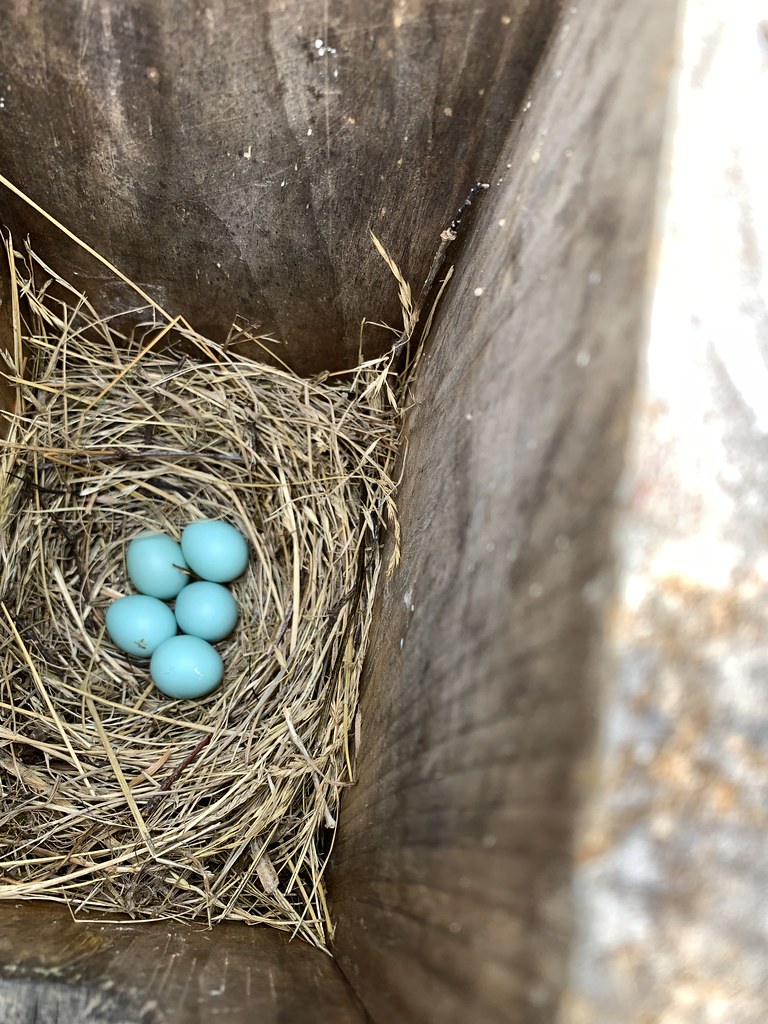
Photo by d a murphy is licensed under CC BY 2.0
The great thing about cavity-nesting birds like Eastern Bluebirds, is that you can actually attract them to your yard by putting up a bird house for them to build their nest in. Learn more about how you can attract Eastern Bluebirds to your yard with a bird house in the article that I wrote here, called: How to Attract Bluebirds.
Indigo Bunting Nests

Instead of nesting in cavities, Indigo Buntings typically choose a hidden nesting site in low shrub or tree, a few feet off the ground, preferably one that has a good supporting network of branches and twigs. Female Indigo Buntings build their nests alone out of woven leaves, grasses, roots, barks, and spider web. The female Indigo Bunting will lay about 3-4 white eggs per clutch that may have occasional brown spots. The incubation period for the eggs is 11-14 days and the young birds will spend and additional 8-14 days in the nest (source).
Do Eastern Bluebirds and Indigo Buntings Get Along?

Photo by Andy Reago & Chrissy McClarren is licensed under CC BY 2.0
As a general rule, Eastern Bluebirds and Indigo Buntings do get along. Since they do not compete for food or nesting sites, the two species rarely interact. Unless they become territorial over a food or water source, it is unlikely that Eastern Bluebirds or Indigo Buntings will harm one another.
Conclusion
There is no denying that both Eastern Bluebirds and Indigo Buntings have some similarities. Mainly, male Eastern Bluebirds and male Indigo Buntings both have bright blue plumage, which they are so rightly named for. However, both bird species are distinct in their size and color markings, and they each have different nesting and diet preferences. Regardless of their differences, they are both beautiful birds to spot in your back yard.
If you’re interested in attracting bluebirds to your back yard, check out my article called How to Attract Bluebirds here.

